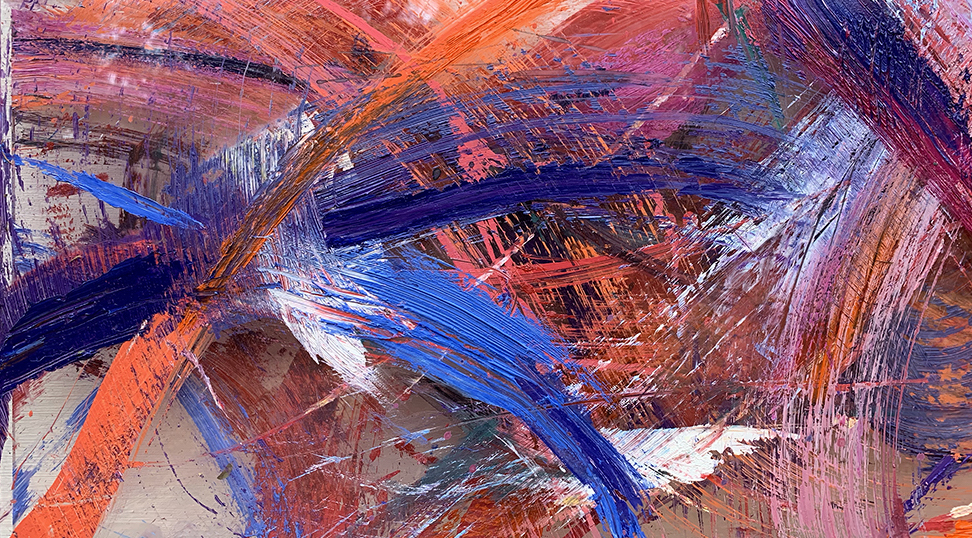
01 Mar Slate Gray March: “Immerse,” 4 Emerging Abstract Painters
March 5, 2020 marks the third Telluride Arts’ Art Walk of the New Year. Through the month (and opening with Art Walk), Slate Gray Gallery Telluride is featuring the work of four emerging abstract painters: Andrew Brown, Daniel Kanow, Phillip Timper, and Niki Woehler. Go here for an overview of all participating Art Walk venues.
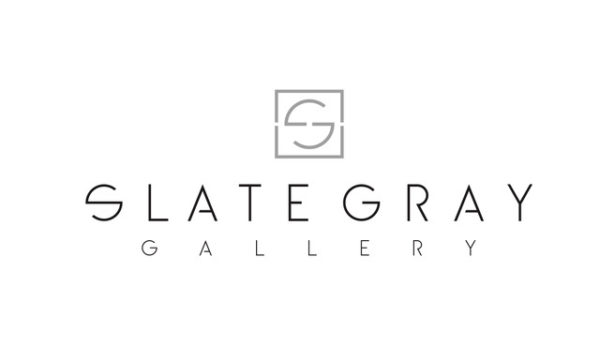
Roger Eliot Fry (1866 – 1934) was an English painter, renowned art critic, and champion of modern art. In a lecture at the Fabian Society in 1917, Fry said: “In proportion as art becomes purer, the number of people to whom it appeals gets less.” And to an extent, Fry was right: in general, the gallery-going public seems to respect, rather than love abstraction.
And yet, to the question of what best defined 20th-century art, especially in the second half of the century, the answer would have to be abstraction. Back then, abstraction was the holy grail of the art world, shape-shifting as it did – does – from worldliness to mystical purity in the blink of an artist’s inner eye.
Like serious jazz, abstract art is a many splendored, if somewhat special and refined thing. It is also clearly like a rubber tree, a hardy plant that has survived, even thrived, for over a century, all the adulation – and the contempt – of the art-going public, fisticuffs among critics, and the nightmares of its best practitioners wondering if they might have been better off marching to a different drum.
The artists whose work is on display at the Slate Gray Gallery Telluride during the month of March, four in all, are emerging Southwestern painters with a passion for non-objective art (art that does not represent a recognizable thing). Like all abstract painters, each is driven to bring out the emotional meaning of colors, shapes, and textures for their own sake; each is motivated to search for a visual way to express a visceral impulse.
Bottom line: What you get is what you see.
Andrew Brown:

Andrew Brown
The dominant movement in American painting in the late-1940s and 1950s, Abstract Expressionism was the first major development in art to lead rather than follow European influences. AbEx so energized the American art scene post WWII that New York wound up replacing Paris as the world capital of contemporary art. Strictly speaking, Action Painting translates to a dynamic, impulsive attack on a surface in which paint is applied with gestural movements – scratching, dribbling, splashing – with little or no preconceived idea of what the end result will look like.
It is painting in the zone during which time an artist’s creative interaction with his materials is just as important as the finished product.
The means justifying the ends.
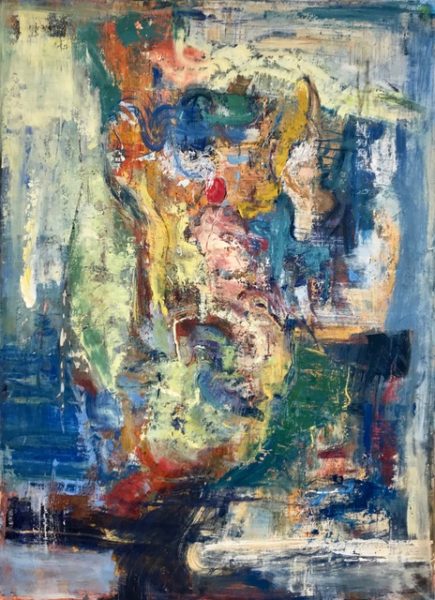
Welcome to the world of Andrew Brown, an artist genetically predisposed to make marks:
“Having grown up surrounded by art my whole life, painting came naturally to me. I enjoyed drawing at an early age and was, so to speak, drawn to old fishing boats in my early years. However, I stopped drawing through high school when my interest shifted to working on cars. But after working on my own vehicle and possibly making it run worse, I decided car play would be a hobby.”
Going forward, however, Brown had no clue about his career path.
“I did know further education wasn’t for me. Fortunately, around the time I was finishing up my senior year, my dad encouraged me to come out to California with him. Slowly it became more and more apparent painting was something I wanted to pursue full time. Now, looking back and into the future, I can’t imagine doing anything else.”
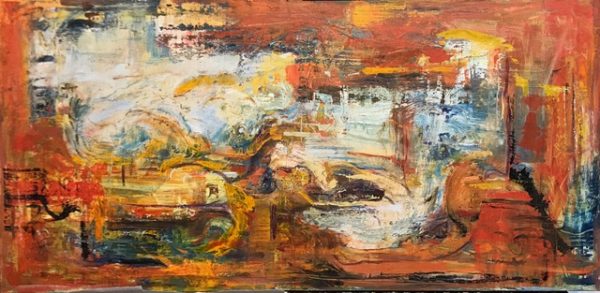
Through the years Brown learned to value the process of making art: “Each new painting provoked a deeper fondness for the medium. I enjoy challenging myself to be bolder and explore new techniques.”
That said, Brown had to warm up to abstract art: “It took time and playing around within my own work for me to enjoy creating non-representational art.”
Today, Brown draws inspiration for his dynamic paintings from the movement and contrasts within a work:
“Nature also influences me: the color in the water, or the way the light breaks through the clouds and hits a landscape, highlighting certain elements just right. I also am drawn to surfaces: when you get up close to a painting, you see more of the layers of paint, textures, and strokes. The biggest thing that inspires me, however, is that I feel as though I have hardly scratched the surface of all there is to learn about making a painting. I want to keep learning by experimenting and staying open and curious.”
![]()
Brown’s artistic influences are wide-ranging – but clearly the apple did not fall very far from the tree. That said, while Brown père’s work tends to depicts an idealized, somewhat (or entirely) abstracted, natural world, his landscapes, and his seascapes feels lyrical and atmospheric, young Brown’s art is raw and intense, reflecting the turbulence of hungry youth. In other words, the very physical young painter Andrew Brown is a true heir of the Abstract Expressionists or “Action Painters” of yore:
“Originally my dad advised me not to become a professional painter, but as I said, I was already drawing and painting in middle school and high school. Then the summer I went out with him to California, I started painting oceanscapes and loved it. For me, painting is a moving meditation and I work off impulse. Lots of stimulants trigger me: a walk at the lake; picking up a new pigment; a podcast, also the art of Joan Mitchell, Gerhard Richter, and Anselm Kiefer.”
Brown is now deep into abstraction because not having to recreate a concrete subject – like a body of water or a tree – helps keep him out of his head, allowing the artist to remain detached and involved at the same time:
“When I first start to paint, my process is unorganized and random. It’s messy, and I enjoy that. It excites me to bring some kind of order to chaos, to create something meaningful out of a blob of paint. But my dad taught me realism and abstraction really come down to the same things: shape, line, color, composition, edges.”
Daniel Kanow:
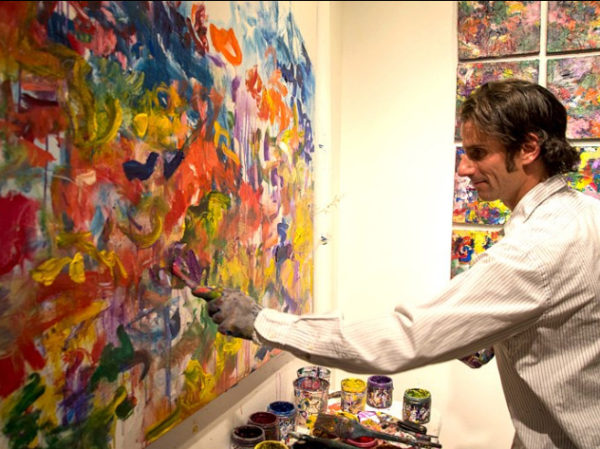
Daniel Kanow received his BFA from UC Santa Cruz and a teaching credential from Humboldt State University. He apprenticed in sculpture with Ted Egri in Taos NM., and is currently a candidate for an MFA degree at the Academy of Art University in California:
“Continuing to push my education as an artist, to have community, and to share my passion with children and adults creates a more rounded path as an artist and educator.”

Passages.

Passages, detail.
Kanow lives in Telluride with his wife Joanna and their two children: Ayla and Shai Ann. His day job is teaching 7th-12th grade art at the Telluride Mountain School where he happily heads the art department:
“In this beautiful place we call home muses abounds. I make art as a way to reach through the looking glass and to find my place in the world. I make art because the process fulfills an inner need to be creative and to think independently while at the same time, grounding myself. In my adulthood, I have been a teacher and an entrepreneur, but continuously an artist engaged in drawing, painting, and sculpture. Art-making is a thread that for me ties together higher learning, experimentation, and reflection.”
Inspired by nature, his children, his students, and animals to be playful, to let go, be loose and unrestricted, Kanow creates abstractions that play in the space of the unknown, a space wide open to interpretation:
“The process of building and taking away is a way of seeing the world through paint, charcoal, clay, wax, and metal. It is a part of me, a chance to gain clarity within my expectations of the world. I began creating non-objective and interpretive abstractions at the beginning of my artistic career. I find pure abstraction analogous to unwinding portraiture of the self.”
For people who look at abstraction and don’t feel they get it, Kanow encourage them to simply surrender:
“By slowing down and looking at the shapes, colors, texture, and the integration of positive and negative spaces, viewers will for sure find a pathway that allows them to enter, understand, and appreciate the work.”

Glacial Melt.

Glacial Melt, detail.
Kanow’s artistic influences are wide-ranging:
“Taos sculptor Ted Egri opened me to the unlimited possibilities making art offers, urging me to always reach heights of creativity that are above and beyond. Locally, Robert Weatherford influenced me to find my own authentic voice. At Ah Haa’s Telluride Painting Academy, I have also had the opportunity to work with Ying Li, where I learned that paint application and process are as important as any final results. Other masters I look toward for inspiration are gestural painters like Joan Mitchell, Kandinsky, Basquiat. My mind also travels back to the ethereal landscapes of Turner and Monet, and the figurative abstraction of Chaim Soutine, Egon Schiele, and Frank Auerbach. In dense works of figuration, I can see the most beautiful abstractions by looking closely at the marks, the layering, and the movement.”
Phillip Timper:
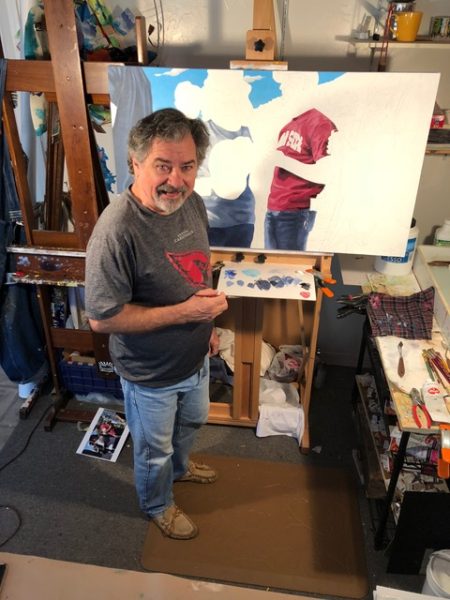
Phillip Timper has been painting for years, having made that career decision at age nine.
“Practically speaking, that’s all I did throughout school. However in my late twenties, I spent a year or so doing construction work, which proved to be an invaluable experience. I hung drywall, built decks, and learned things that I still use today. (My canvases can withstand the most extreme viewing conditions.) For many years, my day job has been working in graphic art and design. As to why I still paint, same reason apple trees make apples: I want to.”

Cross Click
Initially Timper was a realist, going abstract occasionally on a whim. However, inspired by music – “except pan flute” – nature/hiking, dreams, humor, and the love of his life, wife Nancy, recently the artist switched gears, diving into the deep end of pool of possibilities abstraction holds: “Abstraction has rekindled an excitement in painting and opened up new channels in me.”
Timper artistic heroes?
“Motherwell, Fran Kline, de Kooning, Hans Hofmann, Paul Jenkins, and Helen Frankenthaler. Also Toulouse Lautrec, Frans Hals, Maxfield Parrish, Salvador Dali and Frank Zappa are all heroes to me. When I started my abstracts I did not consciously think about their work. I felt the need to jump off that bridge by myself. However we are all the sum of our experiences. And those artists definitely asserted an influence, absolutely.”

Dragonfly
What does Timper have to say to people who might feel intimidated by abstraction?
“Abstract art may not be for everyone, just as the music of pan flute might not be one’s cup of tea. But if confronted in the wild by an abstract work of art, stay calm. Don’t run! Best to look at the image with your heart or your gut rather than your mind. Abstract art is not about words. It is more about sensations. Don’t demand something, open yourself to receiving. You’ll get it.”
Niki Woehler:
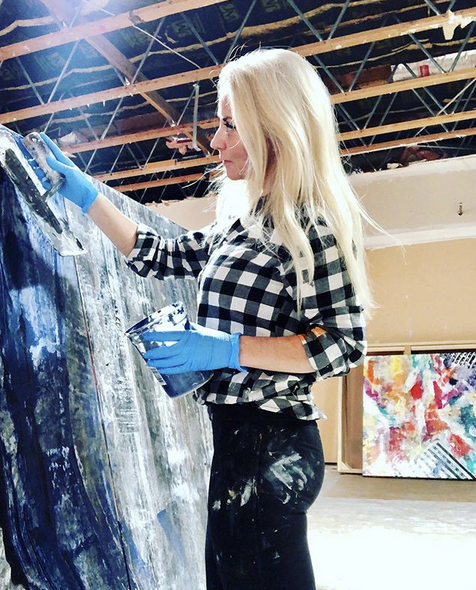
Artist Niki Woehler grew up in Toronto, Canada, but has lived in Phoenix since 1994. She studied broadcasting and marketing at Sheridan College, and spent almost 25 years in the industry, including founding and running a boutique ad agency for more than a decade. Today she makes art because, as she explains, she can’t imagine doing anything else:
“Making art is a part of my soul, who I am. I actually started out in another career direction: I was in marketing for almost 30 years, 12 of them owning my own boutique ad/experiential marketing agency. A little over 20 years ago, I started painting as a way to relax, but kept it to myself. I didn’t tell anyone I was painting because I didn’t want to hear that I wasn’t any good. That would messed with my inner ‘peace.'”
As luck would have it, about eight years ago, one of Woehler’s marketing clients caught her playing “hooky” from work and asked to see her art:
“When I showed my work to this woman, she sent back photos of a blank wall with dimensions and asked me to paint something for her. I did. She loved the painting. And she commissioned two more. That gave me confidence and, as a ‘test,’ I put a painting on Facebook. It sold in under an hour. That happened two more times. Within 30 days, I closed down my agency and have never looked back.”
Abstract art was always Woehler’s thing.
“I think the reason I never liked art in school was because teachers seemed to want me to paint realistically. When I learned how to paint abstractions, however, I found it was freeing. I could create what I felt, not what was expected.”

The Things They Never Tell You.
Today, inspired by objects ravaged by natural elements – water, wind, earth or fire – the way metal, for example, is etched or the patina that comes from the elements, the way colors morph when we squint and look outside at a scene, Niki Woehler is fast becoming one of the most collectable emerging artists in the West. Her large-scale, abstract art – filled as it is with lines, layers, and textures that invade smooth facades – imbues each surface with depth, character, and strength.
“I don’t believe in trying to convince anyone to buy something they don’t resonate with. That is like trying to talk someone into loving you: they do or they don’t. And if they don’t, that’s perfectly ok. The right one is out there. Just the way the right person for each work of art is out there. It’s simply a matter of connection.”
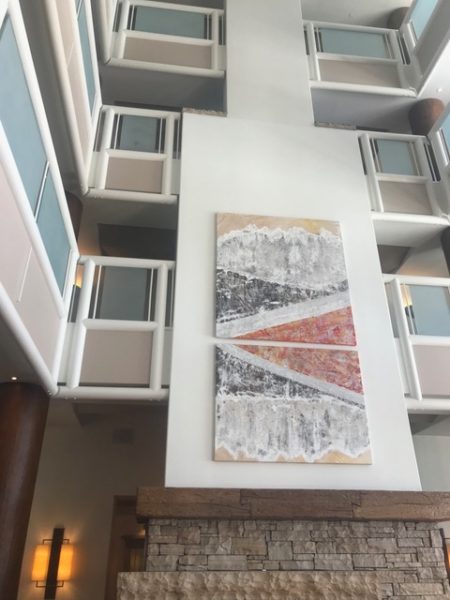
Woehler’s artistic influences?
“I love the work of Ashley Collins and Gerhart Richter the most. The careers they’ve created for themselves, while still alive, are nothing short of inspiring. But, in general, does it sound weird to say that I don’t allow myself to be influenced by other artists? There’s something inside of me that feels as though I need to develop my own voice, so there’s a part of me that is afraid if I study another artist too closely, I might be accused of ‘copying’ their style, and that would devastate me.”
Instead Niki Woehler wants to stand on her own, doing work that is hers and hers alone:
“I play and explore and use trial-and-error to take my work to new levels. I’m influenced by people who follow their passion and explore their craft, whatever that is, and in so doing, make a difference in the world, artists and non artists alike.”
The year 2012 was when Woehler decided to follow her passion and devote herself to painting full time. The lady has never once looked back.


Pingback:Telluride Arts, March Scene | Telluride Inside... and Out
Posted at 19:24h, 02 March[…] Slate Gray Gallery presents a group exhibition titled “Immerse.” The show features four regional emerging abstract painters: Niki Woehler and Andrew Brown, two Abstract Expressionistsm are part of Slate Gray’s regular stable. They are joined by artists new to Slate Graay: local painter and sculptor, Daniel Kanow, and Prescott-based oil painter, Phillip Timper. (Go here for more on that show.) […]